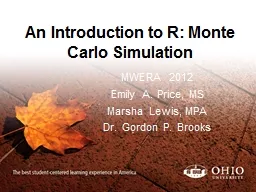

MWERA 2012 Emily A Price MS Marsha Lewis MPA Dr Gordon P Brooks Objectives andor Goals Three main parts Data generation in R Basic Monte Carlo programming eg loops Running simulations eg investigating Type I errors ID: 559862
Download Presentation The PPT/PDF document "An Introduction to R: Monte Carlo Simula..." is the property of its rightful owner. Permission is granted to download and print the materials on this web site for personal, non-commercial use only, and to display it on your personal computer provided you do not modify the materials and that you retain all copyright notices contained in the materials. By downloading content from our website, you accept the terms of this agreement.
Slide1
An Introduction to R: Monte Carlo Simulation
MWERA 2012
Emily A. Price, MS
Marsha Lewis, MPA
Dr
. Gordon P. BrooksSlide2
Objectives and/or GoalsThree main parts
Data generation in R
Basic Monte Carlo programming (e.g. loops)
Running simulations (e.g., investigating Type I errors)Slide3
Why Use Monte Carlo Methods?
According
to Mooney (1997) Monte Carlo simulations are useful
to
Make inferences
when weak statistical theory exists for an estimator
Test null
hypotheses under a variety of plausible conditions
Assess the quality of an inference method
Assess the robustness of parametric inference to assumption violations
Compare estimator’s
properties Slide4
What are Monte Carlo Methods?
Experiments composed of random
numbers
to evaluate
mathematical
expressions (Gentle, 2003)
Empirically
determine the sampling distribution of a test statistic
Computer-based
methods for approximating values and properties of random
variables
(Braun
& Murdoch, 2007
)Slide5
Logic of Monte Carlo
Mooney (1997) presents five steps
Specify the pseudo-population in symbolic terms in such a way that it can be used to generate samples. That is, writing code to generate data in a specific manner.
Sample from the pseudo-population in ways that
reflect the
topic of interest
Calculate
θ
in a pseudo-sample and store it in a
vector
Repeat
steps 2 and 3
t
times where
t
is the number of
trials
Construct
a relative frequency distribution of resulting values which is a Monte Carlo estimate of the sampling distribution of under the conditions specified by the pseudo-population and the sampling proceduresSlide6
Practical Issues/ Considerations
What software to use?
How much time to run the simulation?
Reproducibility of results
Adequacy of random number generator Slide7
Why use R?
It’s FREE
It is a flexible language that can be controlled by the user
It uses a vector based approach
Depending on the package, there are built in commands which the user can access and minimize the amount of programming required for MC simulation
Make sure to load the require packages at the beginning of the session
R
community has a plethora of information:
help websites,
listservs
, textbooks, blogs
Manuals for R available at http://cran.r-project.org/manuals.htmlSlide8
Part 1: Data Generation
RNG and
setting seed
Purpose of the
seed is
to recovery results
Initialize all parameters of interest
Loops
Print results
Access outputSlide9
Generating a Single Random Variable
R has four parts: CDF, PDF,
Quantile
function and simulation procedure
dnorm
,
pnorm
,
qnorm
,
rnorm
respectively
r
norm
(
x,mean
=0,sd=1
)
runif
(20,min=2,max=5
)
Distributions:
normal, uniform,
poisson
, beta, gamma,
chisquare
,
weibull
, exponential Slide10
Try it, you’ll like it!
r
norm
(
x,mean
=0,sd=1
)
G
enerate
a normal distribution
of 50 values with
a mean of 50 and
sd
of
10
x <-
sample(1:2,20,TRUE,prob=c(1/2,1/2))
Generate data that mimics
rolling a
dieSlide11
Generating Correlated Data
X~Normal
(20, 5),
Y~Normal
(40, 10),
corr
(X,Y) =0.6
4 inputs
Sample size, mean, variance-covariance matrix, and method
3 methods of data generation
Eigenvalue (default), Singular
V
alue, and
C
holesky Slide12
Try it, you’ll like it!
rmvnorm
(n,
mean, sigma, method)
Generate data for 3 variables such that
X
--Normal (20, 5), Y-- Normal (40, 10),
Z
-- Normal (60,15
) and
Corr
(X,Y
) =0.6,
Corr
(X,Z) = 0.7,
Corr
(Y,Z)=0.8Slide13
Part 2: Basic MC Programming
Four steps (
Braun
&
Murdoch, 2007
)
Understand the problem
Work out a general idea how to solve it
Flow charts
Translate your general idea into a detailed
implementation
Turn the flowchart into code
Check: Does it work?Slide14
Programming Commands*
Loops
f
or,
i
f,
i
felse
, while
Statements
repeat, break, next
* We can’t cover all programming aspects but wanted to mention other commands
Slide15
Functions
They
are “self-contained units with a well-defined purpose” (Braun & Murdoch
, 2007
, p. 59)
Take
an input, do some
calculations,
and produce an output
In R, functions are objects and can be manipulated like other more common objects such as vectors, matrices, and lists.
R provides source code for its own functions
R allows you to write your own functionsSlide16
Part 3: Running SimulationsTrimmed mean sampling distribution
Replicating a
published Monte Carlo
study
in
R.
Zimmerman
, D. W. (2004). A note on preliminary tests of equality of variances.
British Journal of Mathematical and Statistical Psychology 57
,
173–181.Slide17
QuestionsThank
you for your timeSlide18
References
Braun, W. J., & Murdoch, D. J. (2007).
A first course in statistical programming with R
. New
York: Cambridge
University.
Gentle, J. E. (2003). Random number generation and Monte Carlo methods (2nd ed.). New York: Springer-
Verlag
.
Mooney, C. Z. (1997).
Monte Carlo simulation
(Sage University Paper series on
Quantitative Applications
in the Social Sciences, series no. 07-116). Thousand Oaks, CA: Sage
.
Zimmerman, D. W. (2004). A note on preliminary tests of equality of variances.
British Journal of Mathematical and Statistical Psychology 57
, 173–181.Slide19
Our code Slide20Slide21Slide22Slide23Slide24Slide25